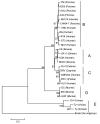Rotavirus G5P[6] in child with diarrhea, Vietnam
- PMID: 17953100
- PMCID: PMC2828068
- DOI: 10.3201/eid1308.061038
Rotavirus G5P[6] in child with diarrhea, Vietnam
Abstract
We detected rotavirus G5P[6] with a long RNA pattern in a Vietnamese child with diarrhea. Viral outer capsid protein VP7 and VP4 genes suggest that it likely originated from porcine rotavirus either by genetic reassortment or as whole virions. To our knowledge, this is the first report of human rotavirus G5 in Asia.
Figures


References
Publication types
MeSH terms
Substances
Associated data
- Actions
- Actions
- Actions
- Actions
LinkOut - more resources
Full Text Sources
Medical
